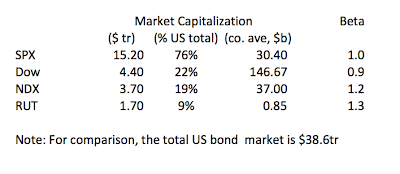Some background: RUT comprises 2000 companies with an average market capitalization of $850m. For SPX, the average company is over $30bn.
These are small companies, much less followed by Wall Street analysts, in turn making them more speculative. The average beta of RUT is about 30% higher than SPX. This is key. When equities are in favor, you should expect RUT to outperform SPX. The reverse is also true when equities fall out of favor.
So is RUT outperformance meaningful to SPX? Not really.
The chart below compares SPX (top panel) to the relative performance of RUT to SPX (bottom panel). When RUT outperforms, the line in the bottom panel rises.
And what we see over the last 10 years is that sometimes SPX rises to new highs when led by RUT (green arrows) and sometimes it does so when RUT lags (red arrows). The relationship is not clean enough to be helpful in understanding SPX better.
What is, in fact, worrisome is that RUT outperformance has often been a precursor to SPX topping out (again, the green arrows). That is essentially the situation today where the level of outperformance is equal to that in mid-2011 before a 20% correction.
First, RUT is a much smaller index than SPX, the Dow or the Nasdaq-100 (NDX). SPX represents about 76% of the total market capitalization of US equities. RUT is just 9%. The 6 largest components of the Dow have a greater combined market capitalization than all 2000 components of the RUT. It's not clear why a small subset should be expected to provide a better reflection on the health of US equities than SPX itself, and that is in fact the empirical case as well.
Second, recall that the volatility of RUT is 30% greater than SPX. Higher risk is typically rewarded with higher return when the market is trending higher. That risk profile is meaningful in understanding investor psychology. When investors are rushing into small caps, they are feeling that equity risk is low. They are very bullish. And that, of course, is the situation we are in today (post).
The conclusions are the following.
First, if you are bullish equities, trading RUT (or NDX) should give you a greater return than SPX or the Dow, but the results historically have been uneven.
Second, when RUT is outperforming, it means investors are very bullish, and a reversal might be in store. Put/call, investors' asset allocation and various surveys should give a similar read.
Finally, SPX is the most representative of total US equities of these four indices. The best tell on the health of SPX is SPX itself.



